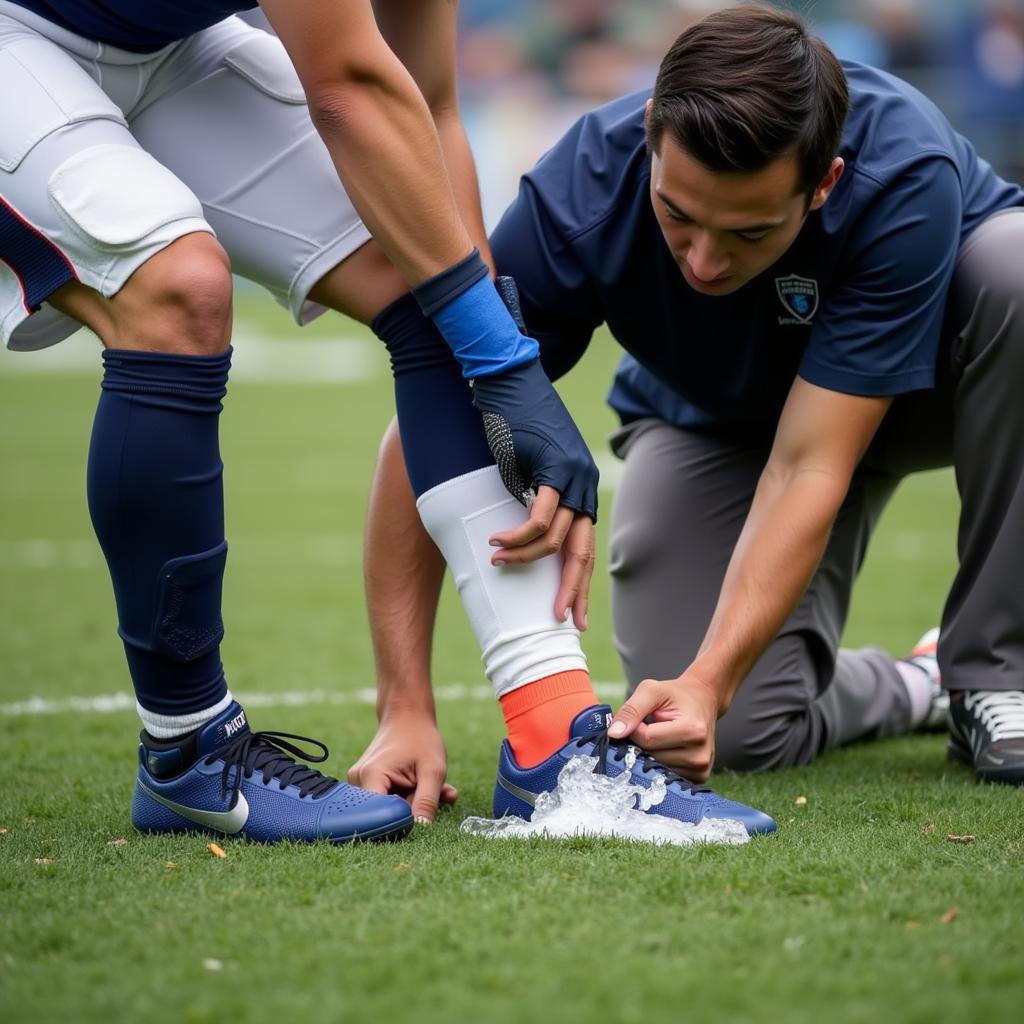Football Player Injuries: A Striker’s Perspective
November 12, 2024Football player injuries are an unfortunate reality of the beautiful game. As a striker, I push my body to the limit every match, constantly striving for peak performance. This puts me at risk, just like any other player, for various types of injuries that can sideline me and hinder my progress. Understanding these injuries, their prevention, and recovery is crucial for any footballer, from aspiring youngsters to seasoned professionals.
Common Football Player Injuries
Football is a high-impact sport demanding speed, agility, and strength, making players vulnerable to a wide range of injuries. Some of the most common include hamstring strains, ankle sprains, ACL tears, and muscle contusions. These injuries can occur from sudden movements, tackles, or overuse. Knowing the mechanisms behind these injuries can help players take preventative measures. Hamstring strains, for instance, often result from explosive sprints, while ankle sprains can happen from awkward landings or tackles.
A player’s position can also influence the type of injuries they’re more susceptible to. Goalkeepers, for example, might experience more finger and hand injuries, while defenders are more prone to head injuries and collisions. Midfielders, with their constant running and tackling, might face groin strains or knee problems. As a striker, I’m particularly aware of the risk of hamstring and groin injuries due to the explosive movements required for quick acceleration and changes in direction.
After a paragraph on the importance of warm-ups and cool-downs for injury prevention.
 Football Player Suffering from a Hamstring Injury
Football Player Suffering from a Hamstring Injury
Preventing Football Player Injuries
Preventing football player injuries is paramount for maintaining peak performance and longevity in the sport. Proper warm-up routines are crucial for preparing the muscles for the demands of the game. Dynamic stretches that mimic game movements are particularly effective. Cool-down exercises after training and matches help reduce muscle soreness and prevent stiffness. Additionally, maintaining good overall fitness, including strength training and cardiovascular exercise, helps build a resilient body less prone to injury.
A healthy diet and adequate hydration play a vital role in injury prevention as well. Proper nutrition provides the building blocks for muscle repair and growth, while hydration ensures optimal muscle function and reduces the risk of cramps and strains. Furthermore, appropriate rest and recovery are essential, allowing the body to repair and rebuild after intense physical exertion. Overtraining can lead to fatigue and increased susceptibility to injuries.
A balanced training program that incorporates rest days and varies the intensity of workouts is crucial. Listening to your body and recognizing early warning signs of pain or discomfort is also vital. Ignoring these signals can lead to more severe injuries. Regular check-ups with a physiotherapist can also help identify potential weaknesses or imbalances that could increase injury risk. These professionals can offer personalized advice and exercises to address specific needs and prevent future problems.
 Applying First Aid to a Football Player with an Ankle Sprain
Applying First Aid to a Football Player with an Ankle Sprain
Recovering from Football Player Injuries
Recovering from a football player injury can be a long and arduous process. The first step is accurate diagnosis, which often involves medical imaging and assessment by a qualified professional. Depending on the severity of the injury, treatment can range from rest and ice to surgery and rehabilitation. Following a prescribed rehabilitation program is crucial for regaining strength, mobility, and function. This typically involves physiotherapy and graded exercises.
The mental aspect of injury recovery is as important as the physical one. Injuries can be frustrating and demoralizing, especially for professional athletes whose careers depend on their physical abilities. Maintaining a positive mindset and focusing on the recovery process is essential. Support from teammates, coaches, and medical professionals can play a significant role in helping players cope with the emotional challenges of injury.
Conclusion
Football player injuries are an unavoidable aspect of the game. Understanding the common types of injuries, their prevention, and the recovery process is essential for all players. By prioritizing prevention strategies, seeking appropriate treatment, and following a structured rehabilitation plan, players can minimize their risk and return to the pitch stronger and more resilient. Football injuries are a setback, but with the right approach, they can be overcome. Remember to prioritize your health and listen to your body.
FAQ
- What are the most common football injuries? Hamstring strains, ankle sprains, and ACL tears are among the most common.
- How can I prevent football injuries? Proper warm-up, cool-down, strength training, and a balanced diet are key.
- What should I do if I get injured during a game? Stop playing immediately and seek medical attention.
- How long does it take to recover from a football injury? Recovery time varies depending on the type and severity of the injury.
- What is the role of physiotherapy in injury recovery? Physiotherapy helps restore strength, mobility, and function.
- How can I stay motivated during injury recovery? Focus on small goals and maintain a positive mindset.
- When can I return to playing after an injury? Follow your doctor’s or physiotherapist’s advice.
See also: xu hướng tấn công của cầu thủ fo3
For support, please contact us at: Phone Number: 0396443476, Email: [email protected] Or visit us at: 23 Tháng 3, Đắk Nia, Gia Nghĩa, Đắk Nông, Việt Nam. We have a 24/7 customer support team.